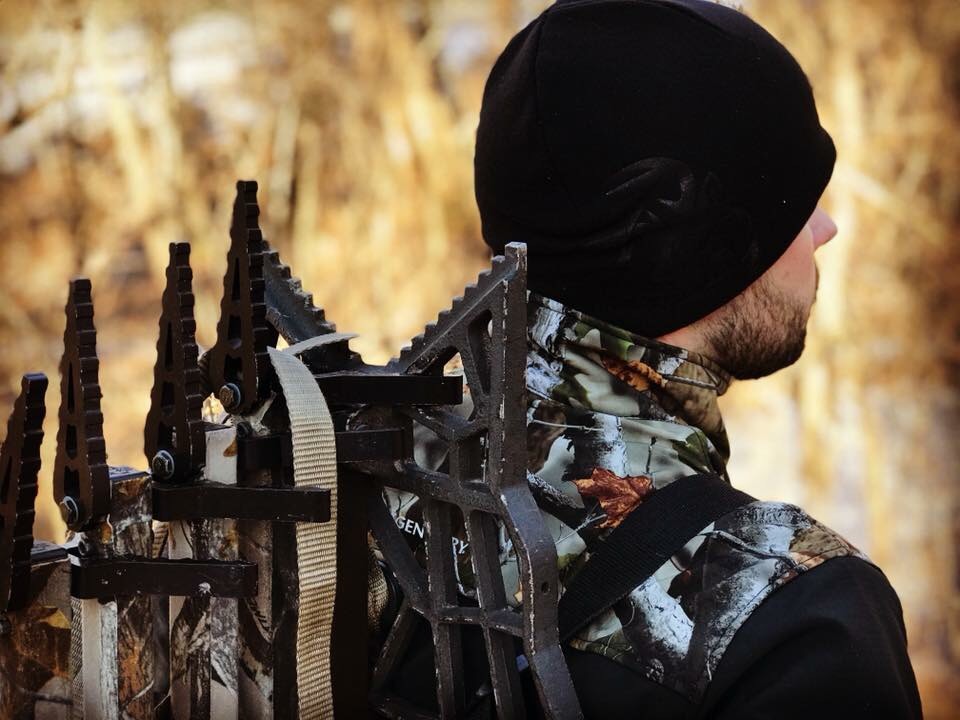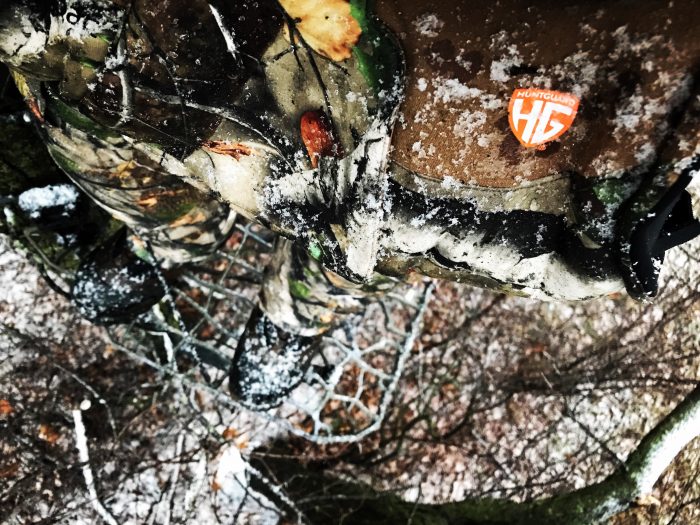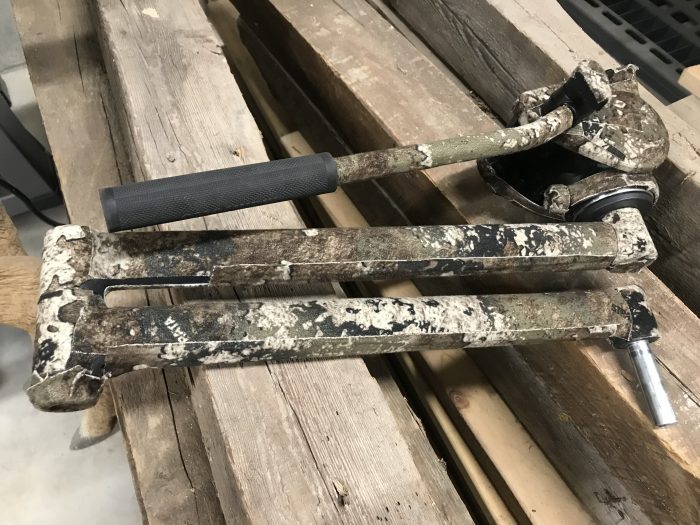I’ve spent the last decade continuously improving strategies for mobile hunting and self-filming. I’m a long way from perfecting the craft, but I’ve made significant strides in ten years. Here are some tested and proven tips and tricks I’ve implemented into my approach. It’s all about packing light and staying quiet while capturing the entire adventure on film.
Silence Your Equipment
One of the biggest obstacles in mobile hunting is getting in and out of your hunting areas quietly. Packing a stand and climbing sticks on your back with a bow in hand is hard enough. Add in the extra weight and obtrusive filming equipment, and you’ve suddenly become a bull in a china shop when you’re trying to be a mouse in a pillow.*
I had read about winding paracord rope tightly around the rim of the stand platform and found it to be a simply strategy for dampening the unavoidable tinging of branches on the aluminum casting. The paracord rope is extremely lightweight, dry’s quickly, & retains strength and integrity for years. I went a step further and sprayed my entire stand platform with a coat of black aerosol liquid rubber sealant spray to further protect the platform.
Other silencing modifications I performed to quiet my gear included Stealth Strips. They are super adhesive mole skin strips of camouflage adaptable to climbing sticks and other outdoor gear. I wrapped my camera arm for the tree, my climbing sticks, & the vertical backbone of my mobile tree stand in Stealth Strips. I’ve found this set up to be about as quiet as any I’ve come across amongst other hunters.
Pack Light
Film equipment is heavy. There’s really no way around that unless you sacrifice quality for a small inexpensive handycam. Handycam’s are light, small, and they’re extremely easy to use. You simply point and shoot. If quality is important to you, that may not be in the cards. Prosumer camcorders and DSLR cameras are heavy and obtrusive. However, they shoot fantastic footage and have the right settings to adjust for lowlight periods, superior zoom, and manual focus.
I’m all for quality when it comes to filming. If I’m going to record my adventure, I’m going to produce a clear picture with premium audio. This also means I’ve had plenty of experience with packing all that equipment. This means extra batteries, lens cleaner, mics, a camera arm, and any other odds and ends that may be necessary. I may even have more equipment, depending on how many cameras I’m lugging in and if I’m shooting from the ground, or in a tree.
But Don’t Forget the Essentials
You could spend a lot on a fancy camera carrying bag with all the right pockets in all the right places. But I opted to go the poor man’s route and spent $12 on a camouflaged shoulder bag from Wal-Mart. The bag has an adjustable strap to sling over a shoulder and enough padding to protect my camera from damage. There are several exterior pockets just large enough to contain the miscellaneous supplies I need, like batteries, as well as the base of my camera arm and external shotgun mic. Moral of the story, you don’t have to spend a fortune if you don’t want to.
Other essential items get packed into a fanny pack. Yes, a fanny pack just like the classic tourist would strap around his waist. My fanny pack is large enough to contain my limb saw, knife, compact bow hanger hook, an extra rope, secondary release, bottle of water, and maybe a sandwich or candy bar. My call, binoculars, and range finder have their place in pockets, clipped to my safety harness, and/or around my neck on a lanyard.
With a stand on my back, a bow in one hand, fanny pack strapped around my waist, and a camera bag over my shoulder, I’m left with one free hand. That one moves branches while I’m entering, or leaving, my hunting area. but what about the camera arm?
I use a ten-inch black rubber bungee strap to hold my camera arm tightly to my stand. I usually strap the camera arm down using a horizontal “V” outline with the bungee strap. The tighter the better to prevent against rattle, slippage, and getting branches caught between your camera arm and stand platform while walking.
Come Prepared
There’s nothing worse than standing at the base of a tree after you’ve hung a set, realizing you forgot to pack a hoist rope or two. Now you’re wondering how you’re going to climb up with your bow and all of your camera gear. I used to bring multiple hoist ropes along, but they’re a pain to wind up and pack neatly in the dark after a long, cold hunt. I’ve found that bringing one forty-foot rope is the most effective method for hoisting your bow and camera gear up the tree.
I like to prep my hoist rope when I hang my mobile stand. Before I climb down, I wrap the rope slightly offset from the middle around a branch and drape both tag ends down to the base of the tree. Once I climb down, I’ll hook my bow to the shortest tag end and the camera equipment to the longest tag end.
When I climb the tree to sit, I’ll first hoist up the bow and hang it on a hook. Next, I’ll assert the base of my camera arm around the tree. Rather than using the ratchet straps usually provided by camera arm manufacturers, I use a BoatBuckle Pro Series Bow Tie Down with Loop End 1 inch x 36 inch. The strap is completely silent, has a 1,200-pound break strength, & fastens extremely tight to the tree with zero play, which eliminates camera shake. The 36-inch length has only been challenged in one tree in the last few years since I’ve added the strap to my system. It works for nearly any tree you can climb with climbing sticks. Forget about the clicking ratchet straps, use a silent strap like this one and you’ll be a ninja in the woods.








